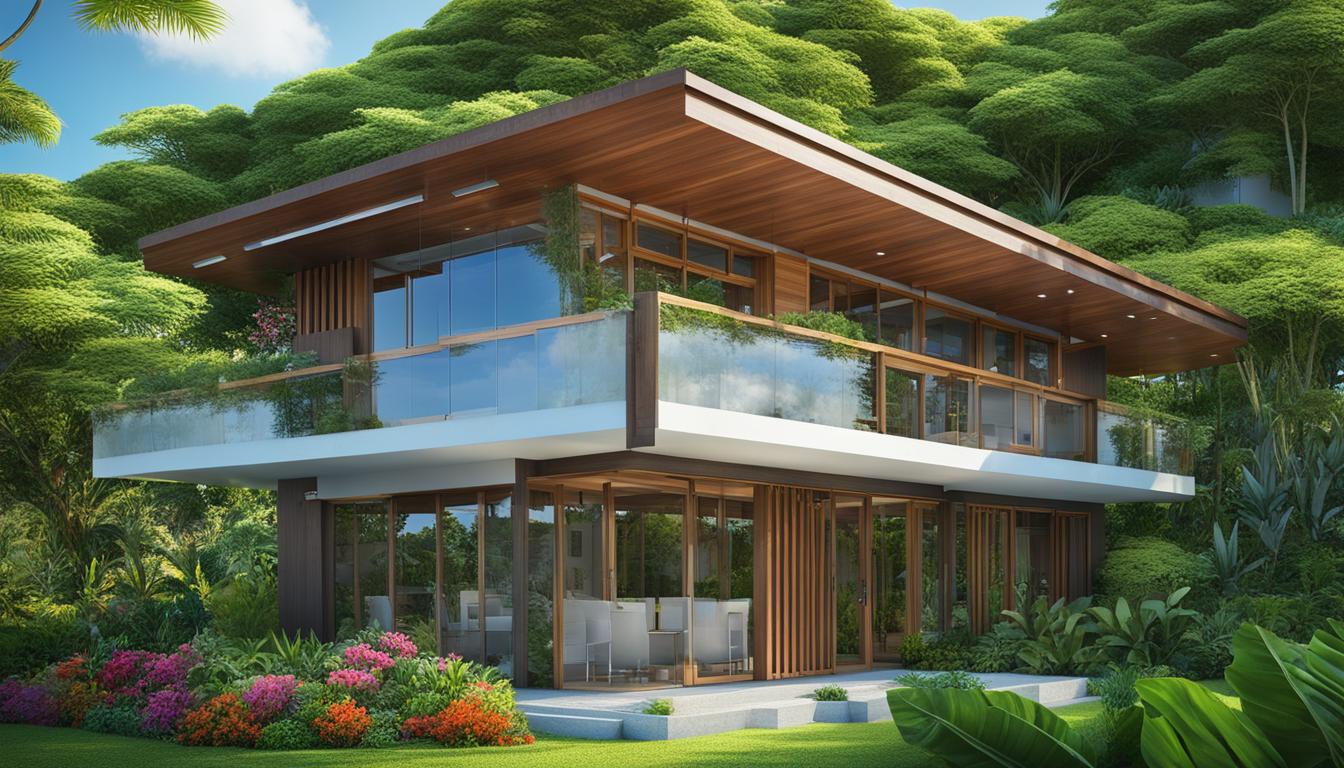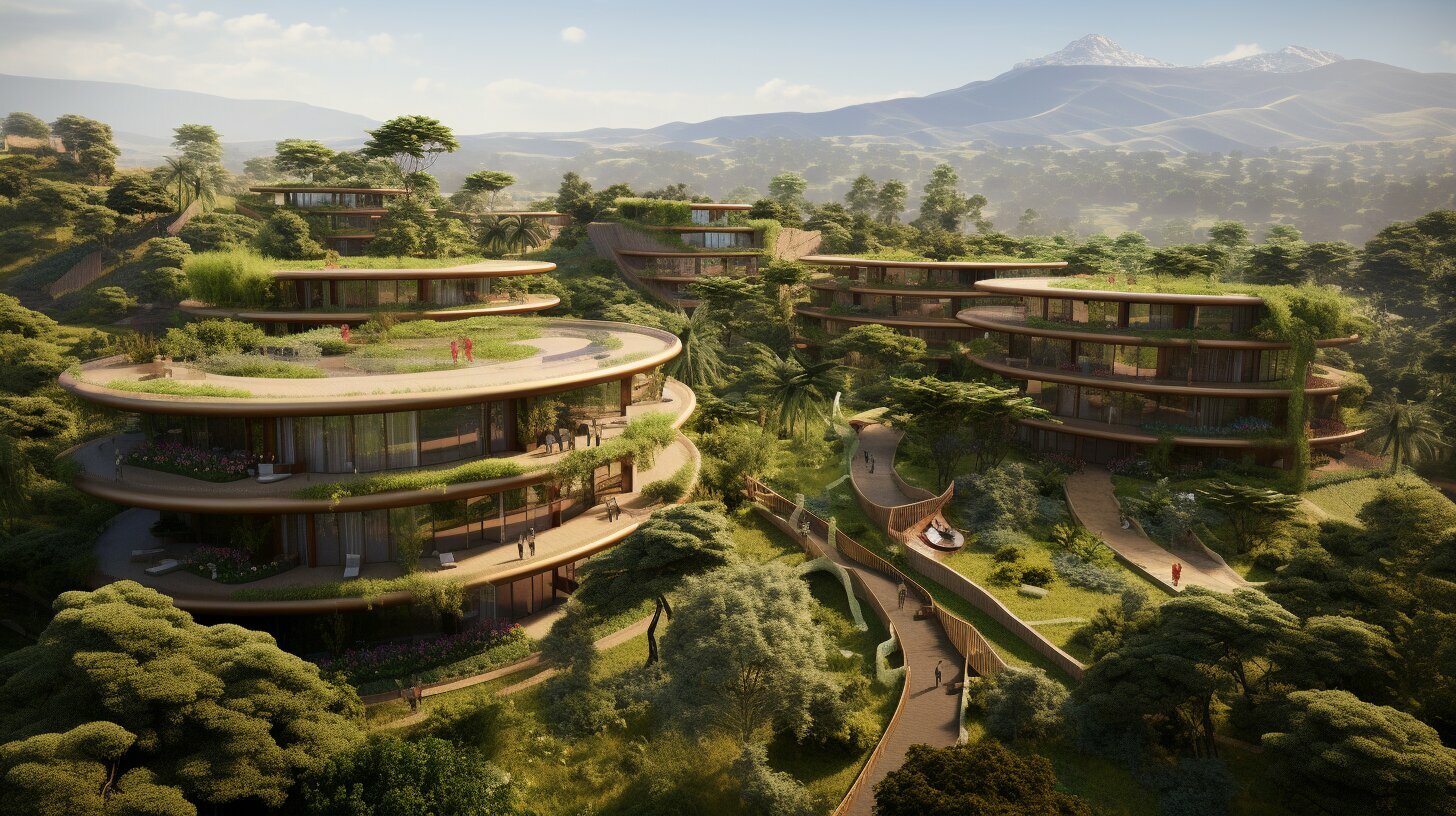Gambia Top Green Buildings
Welcome to Gambia’s top green buildings, leading the way in sustainable architecture and eco-friendly construction in Africa. These innovative structures are being developed to promote sustainability and eco-consciousness in the country, setting an example for the region and beyond.
One notable example is the ecological house and bungalows in Tujereng, Gambia. These buildings were meticulously designed with the aim of being environmentally friendly while respecting local housing traditions. The construction materials used include pressed earth blocks, which are made on-site and exposed in the interior and exterior walls.
The roofs of these buildings are made of wood and straw, providing both tightness and durability. The interior design features high ceilings with exposed wood structures and traditional thatched roofs, showcasing African handcraft and traditional geometric patterns. The buildings are organized around a courtyard that collects rainwater for reuse in irrigation, further reducing their environmental impact.
To ensure self-sufficiency in energy, the complex is equipped with renewable power sources, including solar panels and batteries. This means that all the energy needs of the ecological house and bungalows are met by clean and sustainable energy.
Key Takeaways:
- Gambia’s top green buildings are leading the way in sustainable architecture and eco-friendly construction in Africa.
- The ecological house and bungalows in Tujereng exemplify environmentally friendly construction practices.
- Pressed earth blocks and thatched roofs are used to create sustainable and culturally significant buildings.
- The buildings’ design incorporates features that reduce their environmental impact, such as rainwater collection.
- All the energy needs of the complex are met by renewable power, including solar panels and batteries.
Green Building Design and Materials
Discover the innovative green building design and sustainable materials that make Gambia’s top green buildings stand out. These environmentally friendly structures are at the forefront of sustainable architecture in the country, incorporating eco-conscious practices that promote a greener future.
One remarkable example is the ecological house and bungalows in Tujereng, Gambia. These buildings have been meticulously designed to be in harmony with local housing traditions while utilizing modern green building techniques. The walls of these structures are constructed with pressed earth blocks made on-site, ensuring minimal environmental impact. The use of exposed earth blocks in the interior and exterior walls not only adds a unique aesthetic appeal but also provides excellent insulation, reducing the need for excessive energy consumption.
The roofs of these buildings are made of wood and straw, offering both tightness and durability. This traditional roofing material showcases the rich African handcraft and traditional geometric patterns while contributing to the overall sustainability of the project. Additionally, the high ceilings with exposed wood structures and thatched roofs create a sense of openness and connection with nature.
What sets these top green buildings apart is their commitment to being self-sufficient in terms of energy consumption. The ecological house and bungalows in Tujereng rely entirely on renewable power sources, particularly solar panels and batteries. This allows the buildings to meet all their energy needs sustainably, reducing reliance on non-renewable resources and minimizing their carbon footprint. By incorporating renewable energy solutions, these structures serve as a shining example of how green building design can contribute to a more sustainable future.

| Feature | Description |
|---|---|
| Pressed Earth Blocks | Constructed on-site, these blocks minimize environmental impact and offer excellent insulation. |
| Wood and Straw Roofing | Combining tightness and durability, these roofs showcase local craftsmanship and traditional patterns. |
| Sustainable Materials | The use of eco-friendly materials reduces the carbon footprint and promotes sustainability. |
| Renewable Energy Solutions | Solar panels and batteries provide self-sufficiency in energy consumption, reducing reliance on non-renewable resources. |
Energy Efficiency and Renewable Energy Solutions
Explore the energy-efficient features and renewable energy solutions that make Gambia’s top green buildings pioneers in sustainable development. These buildings are designed with a focus on reducing energy consumption and utilizing renewable energy sources, showcasing the country’s commitment to eco-consciousness.
One exemplary project that embodies these principles is the ecological house and bungalows in Tujereng, Gambia. These structures were built with the aim of being environmentally friendly and in harmony with the local housing traditions. The buildings feature unique construction techniques, such as using pressed earth blocks made on-site, which are exposed in the interior and exterior walls. The roofs are made of wood and straw, providing both tightness and durability.
Furthermore, these green buildings prioritize energy efficiency by incorporating high ceilings with exposed wood structures and thatched roofs. These designs not only showcase African handcraft and traditional geometric patterns but also allow for natural ventilation and cooling, reducing the need for artificial cooling systems. The complex is also self-sufficient in terms of energy, with all power needs being met by renewable sources, including solar panels and batteries.
In addition to the ecological house project, Gambia’s Sustainable Energy Services Company is launching a tender to install rooftop PV systems on 1,000 schools and 99 health facilities as part of the Gambia Sustainable Energy Project. This initiative aims to further enhance the country’s commitment to renewable energy and sustainable development. By harnessing solar power, these buildings will reduce their dependence on traditional energy sources, minimizing their carbon footprint and contributing to a greener future.
| Key Features of Gambia’s Top Green Buildings: |
|---|
| Utilization of pressed earth blocks for construction |
| Wood and straw roofs for tightness and durability |
| High ceilings and thatched roofs for natural ventilation and cooling |
| Solar panels and batteries for self-sufficiency in energy |
A Closer Look: Ecological House in Tujereng
Take a closer look at the ecological house in Tujereng, an exemplary green building project in Gambia that blends sustainable construction techniques with local housing traditions. This eco-friendly house and bungalows were built with the aim of promoting sustainability and environmental consciousness in the country.
The buildings are constructed with pressed earth blocks made on-site and exposed in the interior and exterior walls, creating a visually striking and environmentally friendly design. These blocks not only provide natural insulation but also contribute to the reduction of carbon emissions. The roofs, made of wood and straw, offer both tightness and durability, combining modern construction practices with traditional materials.
The house is organized around a courtyard that collects rainwater for reuse in irrigation, ensuring the efficient use of water resources. Inside, the rooms boast high ceilings with exposed wood structures and thatched roofs, showcasing the beauty of African handcraft and traditional geometric patterns.

The ecological house in Tujereng is not only aesthetically appealing but also designed to be self-sufficient in terms of energy. All energy needs are met by renewable power, including solar panels and batteries. This forward-thinking approach aligns with the sustainable development goals of Gambia’s top green buildings, contributing to a greener future for the country. Furthermore, as part of the Gambia Sustainable Energy Project, the Gambia Sustainable Energy Services Company plans to install rooftop PV systems on 1,000 schools and 99 health facilities, further advancing the use of renewable energy sources throughout the country.
Gambia Sustainable Energy Project
Learn about the Gambia Sustainable Energy Project and its initiative to transform schools and health facilities with rooftop PV systems, driving sustainable development in the country. One of the key focuses of this project is to harness the power of renewable energy to meet the energy needs of these institutions while reducing carbon emissions and promoting a greener future.
Through the installation of rooftop PV systems on 1,000 schools and 99 health facilities, the Gambia Sustainable Energy Project aims to create a more sustainable and environmentally friendly infrastructure. These solar panels convert sunlight into electricity, providing a reliable and renewable source of energy that can offset the reliance on fossil fuels.
The project also highlights the importance of sustainable development in Gambia. By embracing renewable energy solutions, the country can reduce its carbon footprint and contribute to global efforts in combating climate change. This shift towards clean energy demonstrates Gambia’s commitment to a more sustainable future for its citizens and the planet.
With the implementation of rooftop PV systems, schools and health facilities will become self-sufficient in meeting their energy needs. Excess energy can be stored in batteries for use during cloudy days or at night, ensuring a consistent power supply. This not only reduces electricity costs but also creates a reliable energy source that is independent of external factors.
Overall, the Gambia Sustainable Energy Project serves as a shining example of Gambia’s dedication to sustainable development and the promotion of renewable energy. By harnessing the power of the sun, schools and health facilities across the country will not only become self-sufficient but also contribute to the reduction of greenhouse gas emissions. This transformative project paves the way for a greener and more sustainable Gambia.

In conclusion, Gambia’s top green buildings are at the forefront of sustainable architecture and eco-friendly construction, paving the way for a greener future in Africa and beyond. These innovative structures showcase the country’s commitment to promoting sustainability and eco-consciousness.
One notable example is the ecological house and bungalows in Tujereng, Gambia. Built with the aim of being environmentally friendly and in harmony with local housing traditions, these buildings are a testament to Gambia’s dedication to sustainable development. Constructed using pressed earth blocks made on-site, the interior and exterior walls beautifully showcase the natural materials.
The roofs of these buildings are made of wood and straw, ensuring both tightness and durability. Additionally, the house is organized around a courtyard that collects rainwater for reuse in irrigation, further highlighting its eco-conscious design. Inside, the rooms boast high ceilings with exposed wood structures and thatched roofs, showcasing the beauty of African handcraft and traditional geometric patterns.
These green buildings in Gambia are designed to be self-sufficient, with all energy needs being met by renewable power sources. Solar panels and batteries are utilized to harness the abundant sunlight, making the structures energy-efficient and reducing their carbon footprint. Furthermore, the Gambia Sustainable Energy Project, spearheaded by the Sustainable Energy Services Company, aims to install rooftop PV systems on 1,000 schools and 99 health facilities, further promoting sustainable development in the country.
The efforts and achievements in green building construction in Gambia serve as a shining example to other countries worldwide. By prioritizing sustainable architecture and eco-friendly construction practices, Gambia is leading the way towards a greener and more sustainable future for Africa and beyond.
FAQ
What are Gambia Top Green Buildings?
Gambia Top Green Buildings are eco-friendly structures developed to promote sustainability and eco-consciousness in the country. They utilize sustainable architecture and environmentally friendly construction practices.
What design and materials are used in Gambia’s top green buildings?
Gambia’s top green buildings incorporate green building design principles and make use of sustainable building materials. These structures are designed to be environmentally friendly and contribute to a greener future.
How are energy efficiency and renewable energy solutions implemented in Gambia’s top green buildings?
Gambia’s top green buildings prioritize energy efficiency and utilize renewable energy solutions. These buildings implement green building practices to reduce energy consumption and contribute to a more sustainable environment.
Can you provide more information about the ecological house in Tujereng?
The ecological house in Tujereng is a prime example of Gambia’s top green buildings. It is constructed using pressed earth blocks and features thatched roofs, showcasing a harmonious blend of eco-conscious construction and local housing traditions.
What is the Gambia Sustainable Energy Project?
The Gambia Sustainable Energy Project aims to install rooftop PV systems on schools and health facilities in Gambia. This project plays a crucial role in promoting sustainable development and embracing renewable energy solutions.








